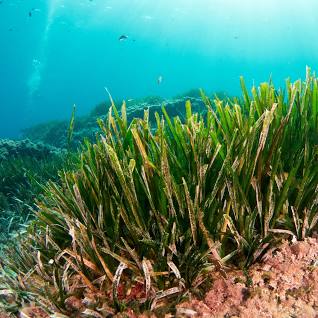Beneath the azure waters of the Mediterranean Sea lies an unsung hero, a seagrass with a botanical name that echoes its mythological significance—Posidonia Oceanica. Commonly known as Neptune grass or Mediterranean tapeweed, this marine plant plays a vital role in the delicate balance of the Mediterranean ecosystem. In this article, we explore the significance, ecology, and conservation importance of Posidonia Oceanica.
Named after the Greek god of the sea, Poseidon, Posidonia Oceanica is a seagrass species that forms vast underwater meadows, stretching across the Mediterranean seabed. Recognized for its long, ribbon-like leaves and distinctive flowering structures, this seagrass is not just a part of the Mediterranean seascape but a fundamental contributor to its health and biodiversity.
Posidonia meadows, often referred to as the “lungs of the Mediterranean,” provide essential ecosystem services. The dense seagrass beds oxygenate the water, releasing oxygen during photosynthesis. These meadows act as crucial nurseries for various marine species, offering shelter and food to juvenile fish and invertebrates.
Posidonia Oceanica meadows are biodiversity hotspots, fostering a rich and diverse array of marine life. The complex structure of the seagrass provides a habitat for a myriad of species, including seahorses, cuttlefish, and numerous fish species. The intricate network of Posidonia roots stabilizes the seabed, preventing erosion and maintaining water clarity.
The health of Posidonia meadows serves as an environmental indicator for the overall well-being of the Mediterranean Sea. Sensible to changes in water quality and human activities, the decline of Posidonia meadows often signals broader ecological issues, making it a sentinel species for monitoring the marine environment.
Despite its ecological importance, Posidonia Oceanica faces numerous threats, primarily stemming from human activities. Coastal development, anchor damage, pollution, and climate change pose significant challenges to the survival of these seagrass meadows. Efforts in conservation and sustainable management are crucial to preserving the health of Posidonia and the broader marine ecosystem.
Several conservation initiatives and research projects are dedicated to safeguarding Posidonia Oceanica. These efforts involve community engagement, habitat restoration, and the establishment of marine protected areas. Raising awareness about the importance of Posidonia and promoting sustainable practices is integral to ensuring the longevity of these underwater meadows.
For those exploring the Mediterranean’s underwater wonders, responsible tourism is key to preserving Posidonia meadows. Divers and snorkelers can contribute by adhering to established guidelines, avoiding contact with the seagrass, and participating in local conservation initiatives.
In conclusion Posidonia Oceanica, with its mystical name and ecological significance, embodies the delicate balance of life beneath the Mediterranean waves. As a guardian of biodiversity and a barometer of environmental health, this seagrass plays a vital role in the intricate dance of the sea. It calls upon us, as stewards of the oceans, to appreciate, protect, and actively contribute to the conservation of Posidonia Oceanica—a green guardian silently working to ensure the vitality of the Mediterranean ecosystem.

Recent Comments